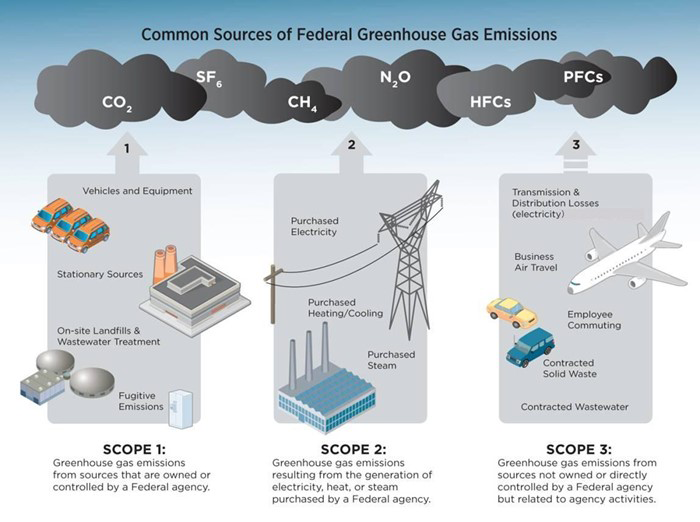Greenhouse Gas Accounting
A variety of greenhouse gas (GHG) accounting protocols are available for reporting emissions, such as the World Resources Institute (WRI) and World Business Council for Sustainable Development (WBCSD) GHG Protocol Corporate Standard![]() .
.
For federal agencies, see the White House Council on Environmental Quality (CEQ) GHG Guidance![]() and the Federal Comprehensive Annual Energy Reporting Requirements
and the Federal Comprehensive Annual Energy Reporting Requirements![]() from the Department of Energy's Federal Energy Management Program (FEMP).
from the Department of Energy's Federal Energy Management Program (FEMP).
Emission Scope
For accounting purposes, GHGs are divided into 3 standard categories, or "scopes":
- Scope 1 Direct (Onsite) Emissions
- Stationary fuel combustion – boilers, emergency generators, on-site heat and power production
- Mobile combustion – vehicles and mobile equipment
- Fugitive emissions – refrigerants, on-site landfills and wastewater treatment, electrical equipment/switchgears
- Process emissions – cement production
- Scope 2 Indirect Emissions
- Electricity – U.S. EPA eGRID
 provides emission factors to convert electric energy purchases into GHG emissions
provides emission factors to convert electric energy purchases into GHG emissions - Purchased steam, hot water, and chilled water – depends on provider fuel use
- Combined Heat and Power
- Electricity – U.S. EPA eGRID
- Scope 3 Indirect Emissions
- Transmission and Distribution (T&D) – losses from off-site purchases of electricity, steam, hot water, and chilled water
- Business travel – ground transportation and air travel
- Commuter travel
- Contracted wastewater – wastewater treatment plants and septic
- Contracted waste – landfill emissions and incineration

How to Calculate Emissions
Step 1: Calculate the emissions from each GHG
Activity x Emission Factor (Tons GHG/activity unit) = Emissions (Tons GHG)Activities such as burning fossil fuels release several types of gases into the atmosphere. The amount of each gas released per unit of the activity (e.g., ton of coal burned) is referred to as an "emission factor". These can be calculated from direct measurement, measured carbon or energy content of the fuel, or based on the chemical formula. See the EPA GHG Emission Factors Hub![]() for an "easy-to-use set of default emission factors".
for an "easy-to-use set of default emission factors".
Step 2: Calculate CO2 equivalents (CO2e) for each GHG and sum overall emissions
Emissions x Global Warming Potential (GWP) = Total Emissions (Tons CO2e)Each protocol will have recommended factors for global warming potential in order to convert all emissions into a single unit (CO2e) that can be summed across all GHG. The table below includes several common values.
| Emission | GWP | Emission Source |
|---|---|---|
| Carbon dioxide (CO2) | 1 | Mobile and stationary combustion |
| Methane (CH4) | 25 | Coal mining, fuel combustion, landfills, wastewater treatment |
| Nitrous Oxide (N2O) | 298 | Fuel combustion, fertilizers |
| Hydrofluorocarbons (HFCs) | 12-14,800 | Refrigerants, fire suppressants, various manufacturing processes |
| Perfluorocarbons (PFCs) | 7,390-12,200 | Electrical equipment, various manufacturing processes, refrigerants, medicine |
| Sulfur Hexafluoride (SF6) | 22,800 | Electrical equipment, various manufacturing processes, tracer in air modeling, medicine |
| Nitrogen Trifluoride (NF3) | 17,200 | Industrial processes, primarily produced in the manufacture of semiconductors and LCD (Liquid Crystal Display) panels, and certain types of solar panels and chemical lasers |
Related Topics
Greenhouse Gases
Gases that trap heat in the earth’s atmosphere are called greenhouse gases. Examples of greenhouse gases include carbon dioxide![]() , methane, and chlorofluorocarbons. The primary source of carbon dioxide emissions is the combustion of fossil fuels for energy.
, methane, and chlorofluorocarbons. The primary source of carbon dioxide emissions is the combustion of fossil fuels for energy.
EPA | Greenhouse Gas (GHG) Emissions![]()
FEMP | Annual Greenhouse Gas and Sustainability Data Report![]()
Greenhouse Gases (GHG)
A range of human activities cause the release of greenhouse gases into the atmosphere (e.g., the release of carbon dioxide during fuel combustion). These gasses can damage or be trapped in the earth’s atmospheric layers, contributing to global climate change.
EPA | Greenhouse Gas (GHG) Emissions![]()
Scope 1 Greenhouse Gases
Direct greenhouse gas emissions from sources that are owned or controlled by the Federal agency.
Sustainability.gov | Federal Greenhouse Gas Accounting and Reporting Guidance![]()
Scope 2 Greenhouse Gases
Direct greenhouse gas emissions resulting from the generation of electricity, heat, or steam purchased by a Federal agency.
Sustainability.gov | Federal Greenhouse Gas Accounting and Reporting Guidance![]()
Scope 3 Greenhouse Gases
Greenhouse gas emissions from sources not owned or directly controlled by a Federal agency but related to agency activities, such as vendor supply chains, delivery services, and employee travel and commuting.
Sustainability.gov | Federal Greenhouse Gas Accounting and Reporting Guidance![]()
